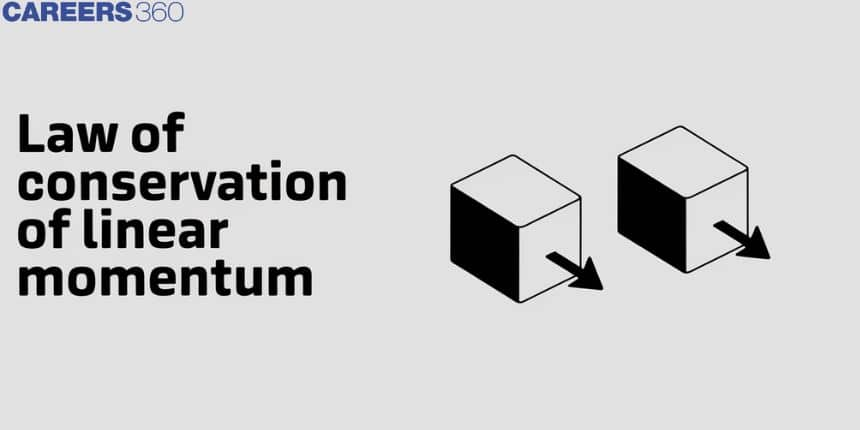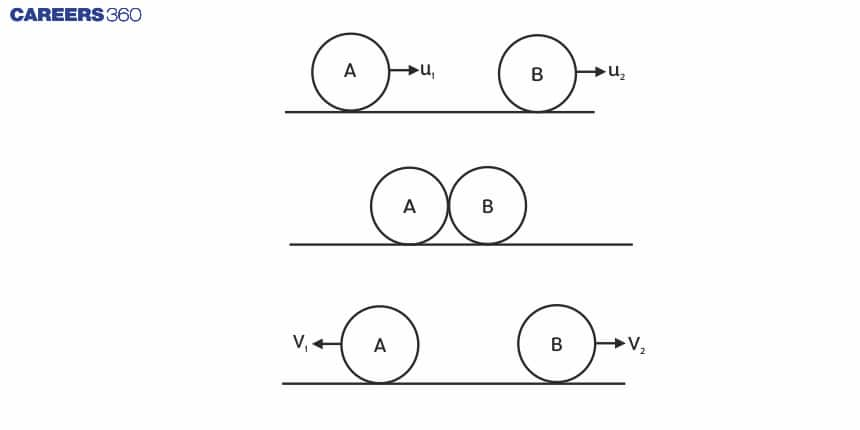Law of Conservation of Linear Momentum - Examples, FAQs
When two cars collide, the total momentum before and after the collision is the same, even though the cars may change speed or direction. This case can be better understood by studying the Law of Conservation of Linear Momentum in Physics. The below article will help us to understand the Law of Conservation of Linear Momentum with their examples in detail.
JEE Main/NEET 2027: Physics Important Formulas for Class 10
NEET 2025: Mock Test Series | Syllabus | High Scoring Topics | PYQs
JEE Main: Study Materials | High Scoring Topics | Preparation Guide
JEE Main: Syllabus | Sample Papers | Mock Tests | PYQs
This Story also Contains
- State the Law of Conservation of Linear Momentum
- Law of Conservation of Momentum Derivation
- Example of Law of Conservation of Linear Momentum
- Solved Example Based on Conservation of Linear Momentum

State the Law of Conservation of Linear Momentum
The law of conservation of linear momentum works on the principle that when no external forces act on a system of two colliding objects, the vector sum of their linear momentum remains constant and is unaffected by their mutual interaction.
"The law of conservation of linear momentum states that if a system's net external force is zero, the system's total momentum remains constant."
S.I Unit of linear momentum is
Law of Conservation of Linear Momentum Formula
Where:
- p: Linear momentum (vector quantity)
- v: Velocity of the object (vector quantity)
Characteristics of Linear Momentum
-
Linear momentum of a body is the quantity of motion contained in the body.
-
It is measured in terms of the force required to stop the body in a unit time.
-
If a body of mass
-
It is a vector quantity and its direction is the same as the direction of the velocity of the body.
-
S.I. Unit: kg-m/sec
-
Dimension
-
If two objects of different masses have the same momentum, the lighter body possesses greater velocity.
Also read -
- NCERT Notes For All Subjects
- NCERT Solutions for All Subjects
- NCERT Exemplar Solutions for All Subjects
Commonly Asked Questions
Law of Conservation of Momentum Derivation
When object A exerts a force on object B, object B reacts with a force of equal magnitude but in the opposite direction, according to Newton's Third Law of Motion
The principle of conservation of momentum is deduced from Newton's third law of motion
Consider two colliding particles A and B with masses of
As shown in the figure:

The change in the momentum of particle A is:
The change in the momentum of particle B is:
Using Newton's Third Law of Motion, we can write:
Substituting for the forces:
Equating the two:
Simplifying the equation:
As a result, if no external force is exerted on the system, the momentum after the collision is equal to the momentum before the collision.
As a result, the equation of the law of conservation of momentum is as follows:
Example of Law of Conservation of Linear Momentum
- A Gun's Recoil: When a bullet is shot from a gun, both the bullet and the gun are initially at rest, with zero total momentum. When a bullet is fired, it accelerates forward. As a result of conservation momentum, the cannon acquires a backward momentum. A bullet with mass m is discharged at a forward velocity of v. The mass M gun achieves a rearward velocity u. The overall momentum before firing a bullet from the gun is zero, and the total momentum after firing is also zero.
- Rocket propulsion involves a gas chamber at one end from which gas is expelled at high velocity. The total momentum is zero before the ejection. The rocket obtains a rebound velocity and acceleration in the opposite direction due to the ejection of gas. This occurs as a result of momentum conservation.
- Motorboats: To conserve momentum, they push the water backward and forward.
These are some of the examples of the conservation of linear momentum that we see in our day-to-day lives. Now we will see some solved examples of the law of conservation of linear momentum.
Recommended Topic Video
Solved Example Based on Conservation of Linear Momentum
Question 1: An object of mass 1 kg travels at a constant speed of 10 m/s. Calculate the linear momentum (in kg-m/s )of the object.
(a) 10
(b) 40
(c) 30
(d) 15
Solution:
Given : Mass,
Linear momentum,
Hence, the answer is option (a).
Question 2: If the speed and mass of an object are doubled, which of the following is true?
(a) The momentum of the object is doubled
(b) The momentum of the object is quadrupled.
(c) The momentum remains the same.
(d) The momentum is halved.
Solution:
Given :
Speed,
Mass,
We know,
Momentum,
According to the question if mass and speed are doubled. Then,
Hence, the answer is option (b).
Question 3: A ball of mass 0.20 kg hits a wall at an angle of
(a)
(b) 5 Ns
(c)
(d) 10 Ns
Solution:
Given-
mass,
initial and final speed,
Magnitude of Initial linear momentum
Angle between initial and final momemtum vectors is

Change in linear momentum-
Hence, the answer is an option (a)
Question 4: An object is thrown vertically upwards. At its maximum height, which of the following quantities becomes zero?
(a) Momentum
(b) Potential Energy
(c) Acceleration
(d) Force
Solution:

At maximum height, its velocity becomes zero. Therefore, the momentum of the object becomes zero
The correct option is (1)
Question 5: A body of mass
(a)
(b)
(c)
(d)
Solution:
Conservation of momentum,
Hence, the Correct answer is Option (b).
Commonly Asked Questions
Frequently Asked Questions (FAQs)


